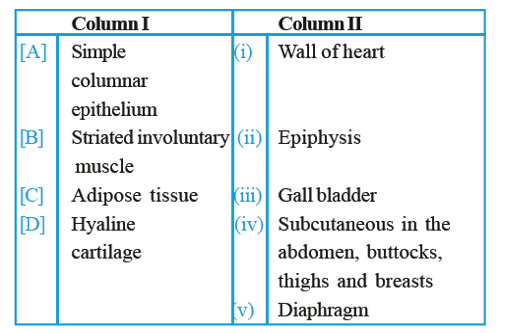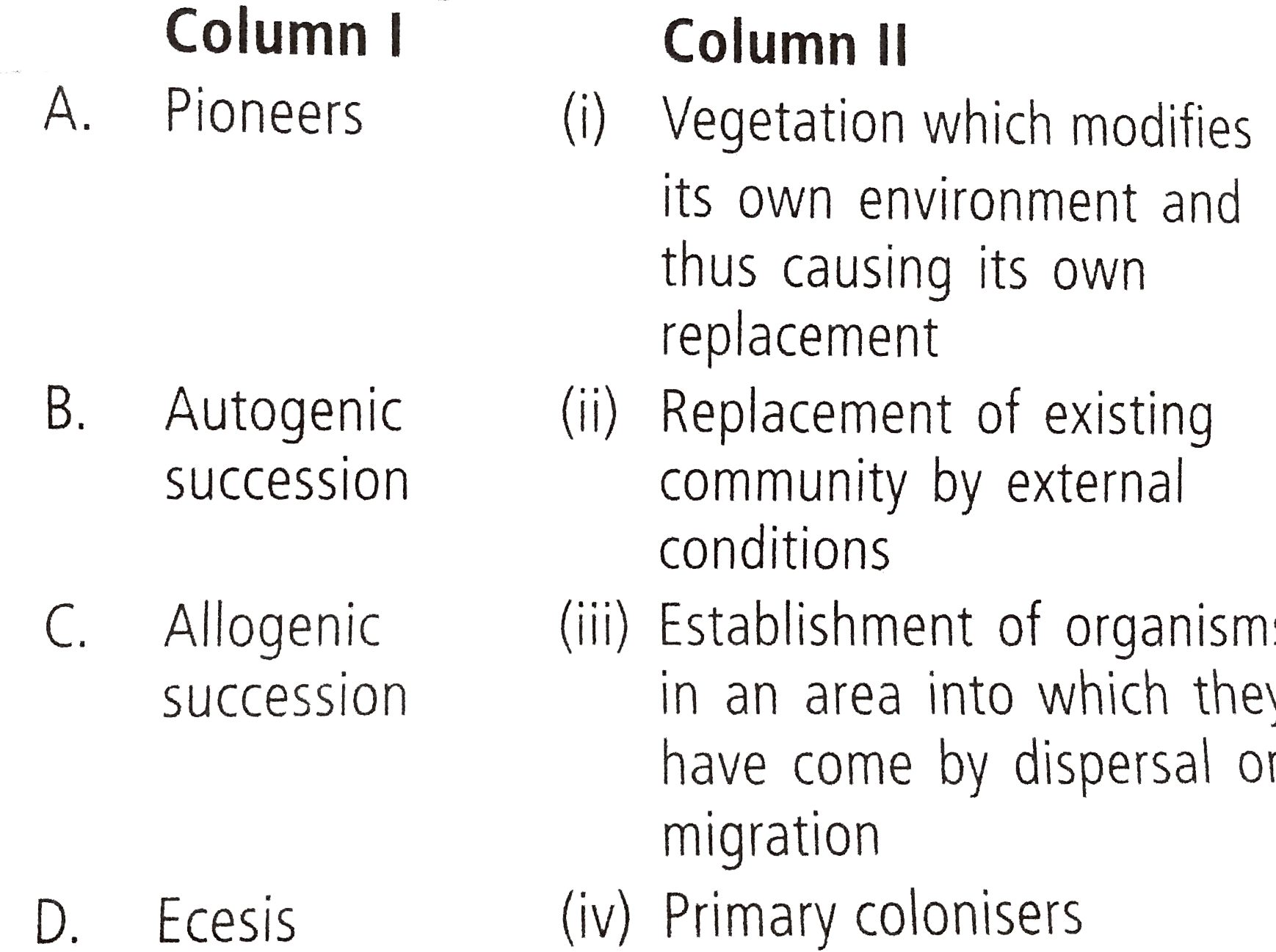Match column I with column II and select the correct option from the codes given below.
Column IColumn IIA.Nucleolus(i)Lipid storageB.Sphaerosomes(ii)Glycolate metabolismC.Peroxisomes(iii)Transport of macromoleculesD.Plasmodesmata(iv)RNA synthesis
a) ABCD(iv)(i)(iii)(ii)
b) ABCD(i)(ii)(iv)(iii)
c) ABCD(iv)(i)(ii)(iii)
d) ABCD(i)(ii)(iii)(iv)
The correct Answer is:C
To solve the matching question between Column I and Column II, we need to identify the correct functions for each of the cell organelles listed in Column I. Let's go through each option step by step.
1. Identify the function of Nucleolus (A):
- The Nucleolus is located inside the nucleus of the cell and is primarily responsible for the synthesis of RNA.
- Match: Nucleolus (A) → RNA synthesis (iv).
- Result: A = iv (4).
2. Identify the function of Sphaerosomes (B):
- Sphaerosomes are specialized structures in plant cells that are involved in lipid storage.
- Match: Sphaerosomes (B) → Lipid storage (i).
- Result: B = i (1).
3. Identify the function of Peroxisomes (C):
- Peroxisomes contain enzymes, including peroxidase, which are involved in the metabolism of glycolate.
- Match: Peroxisomes (C) → Glycolate metabolism (ii).
- Result: C = ii (2).
4. Identify the function of Plasmodesmata (D):
- Plasmodesmata are channels that connect adjacent plant cells, facilitating the transport of macromolecules between them.
- Match: Plasmodesmata (D) → Transport of macromolecules (iii).
- Result: D = iii (3).
Summary of Matches:
- A (Nucleolus) → iv (RNA synthesis)
- B (Sphaerosomes) → i (Lipid storage)
- C (Peroxisomes) → ii (Glycolate metabolism)
- D (Plasmodesmata) → iii (Transport of macromolecules)
Final Matching:
- A = 4
- B = 1
- C = 2
- D = 3
Correct Option:
The correct option that matches these results is Option C: A4, B1, C2, D3.
---
- The Nucleolus is located inside the nucleus of the cell and is primarily responsible for the synthesis of RNA.
- Match: Nucleolus (A) → RNA synthesis (iv).
- Result: A = iv (4).
- Sphaerosomes are specialized structures in plant cells that are involved in lipid storage.
- Match: Sphaerosomes (B) → Lipid storage (i).
- Result: B = i (1).
- Peroxisomes contain enzymes, including peroxidase, which are involved in the metabolism of glycolate.
- Match: Peroxisomes (C) → Glycolate metabolism (ii).
- Result: C = ii (2).
- Plasmodesmata are channels that connect adjacent plant cells, facilitating the transport of macromolecules between them.
- Match: Plasmodesmata (D) → Transport of macromolecules (iii).
- Result: D = iii (3).
- A (Nucleolus) → iv (RNA synthesis)
- B (Sphaerosomes) → i (Lipid storage)
- C (Peroxisomes) → ii (Glycolate metabolism)
- D (Plasmodesmata) → iii (Transport of macromolecules)
- A = 4
- B = 1
- C = 2
- D = 3
The correct option that matches these results is Option C: A4, B1, C2, D3.
Topper's Solved these Questions
- BOOK - NCERT FINGERTPS ENGLISHCHAPTER - CELL - THE UNIT OF LIFEEXERCISE - HOTS5videos
CELL - THE UNIT OF LIFE
- BOOK - NCERT FINGERTPS ENGLISHCHAPTER - CELL - THE UNIT OF LIFEEXERCISE - NCERT14videos
CELL - THE UNIT OF LIFE
- BOOK - NCERT FINGERTPS ENGLISHCHAPTER - BREATHING AND EXCHANGE OF GASESEXERCISE - Breathing And Exchange Of Gases140videos
BREATHING AND EXCHANGE OF GASES
- BOOK - NCERT FINGERTPS ENGLISHCHAPTER - CELL CYCLE AND CELL DIVISIONEXERCISE - Cell Cycle And Cell Division130videos
CELL CYCLE AND CELL DIVISION
Similar Questions
Match Column I with Column II and select correct option from the codes given below.
 View Solution
View SolutionMatch column I with column II and select the correct option from the codes given below.
Column IColumn IIA.Mitochondria(i)Without membraneB.Lysosomes(ii)Single membraneC.Ribosomes(iii)Double membraneD.NucleusView Solution
Knowledge Check
- Question 1 - Select One
Match column I with II column II and select the correct option from the given codes .
 AA-(ii), B-(iii), C-(iv), D-(i)BA-(iii), B-(ii), C-(i), D-(iv)CA-(iii), B-(ii), C-(iv), D-(i)DA-(i), B-(ii), C-(iii), D-(iv)
AA-(ii), B-(iii), C-(iv), D-(i)BA-(iii), B-(ii), C-(i), D-(iv)CA-(iii), B-(ii), C-(iv), D-(i)DA-(i), B-(ii), C-(iii), D-(iv) - Question 2 - Select One
Mathc column I with column II and select the correct option from the given codes.
 AA-(ii), B-(iii), C-(iv), D-(i), E-(v)BA-(v), B-(iv), C-(iii), D-(i), E-(ii)CA-(i), B-(iii), C-(iv), D-(ii), E-(v)DA-(i), B-(iv), C-(iii), D-(ii), E-(v)
AA-(ii), B-(iii), C-(iv), D-(i), E-(v)BA-(v), B-(iv), C-(iii), D-(i), E-(ii)CA-(i), B-(iii), C-(iv), D-(ii), E-(v)DA-(i), B-(iv), C-(iii), D-(ii), E-(v) - Question 3 - Select One
Mathc column I with column II and select the correct option from the given codes.
 AA-(iii),B-(v), C-(iv),D-(ii)BA-(ii),B-(iv),C-(v),D-(i)CA-(ii),B-(iv),C-(v),D-(iii)DA-(iii), B-(v), C-(iv), D-(i)
AA-(iii),B-(v), C-(iv),D-(ii)BA-(ii),B-(iv),C-(v),D-(i)CA-(ii),B-(iv),C-(v),D-(iii)DA-(iii), B-(v), C-(iv), D-(i)
Match column I with column II and select the correct option from the codes given below.
Column IColumn IIA.Dictyosomes(i)StorageB.Mitochondria(ii)PhotosynthesisC.Vacuoles(iv)TransportD.Grana(iv)Secretion(v)RespirationView SolutionMatch the structures in List - I with the functions in List - II selet the correct answer using the codes given below the lists
List - IList-IIANucleolus1.Lipid storageB.Spherosomes2.β−oxidation of fatty acidsC.Glyoxysome3.Transport of macromoleculesD.Plasmodesmata4.RNA-synthesisView SolutionMatch column I with column II and select the correct option from the codes given below.
Column IColumn IIA.Green revolution(i)Milk productionB.Pisciculture(ii)Crop plantsC.White revolution(iii)Fish productionD.Blue revolution(iv)Rearing of fishesView SolutionMatch column I and II and select the correct option from the given codes.
 View Solution
View SolutionMatch column I with column II and select the correct option from the codes given below.
Column IColumn IIA.Rhizopus(i)AscomycetesB.Penicillium(ii)BasidiomycetesC.Ustilago(iii)DeuteromycetesD.Alternaria(iv)PhycomycetesView Solution
